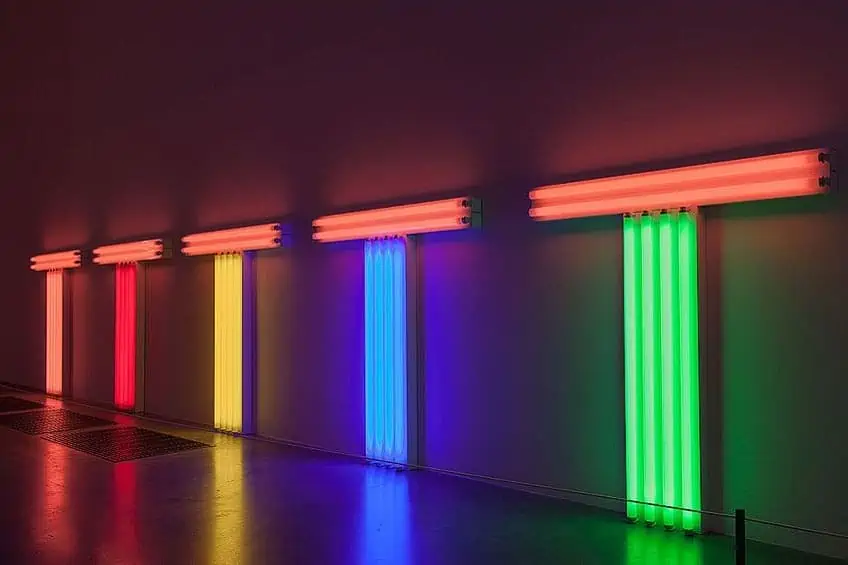Minimalist Art – An Investigation into the Minimalism Art Movement
Many have mixed opinions on Minimalist art – you either hate it, love it, or are at peace with its existence as both conceptual and art for art’s sake purposes. This article will introduce you to Minimalist art and include all you need to know about this art movement that seems to dominate contemporary media from time to time.
Contents
Minimalism: The Art Movement
You may have heard of people preferring a more “minimalist” approach, which seems like a fancy term for describing something as simple yet complex, perhaps both unconventional and conventional. While this may be a superficial view, the art movement Minimalism emerged around the mid-20th century, during a time of great change in the art scene that began to reject the former trend of Abstract Expressionism.
There was more to Minimalism in art than simplicity. Minimalism allowed artists to focus solely on either material or medium as an expression of art itself.
The movement is closely associated with the Abstract art movement and is considered an extension of the movement. Minimalism in art is also associated with conceptual art, which was famous in the 1960s and viewed as radical in interpreting and viewing art.
Minimalist artists also tend to emphasize aesthetics and the “surface” value of media as opposed to an overwhelming scene or installation. Minimalism can also be thought of as associated with blunt and honest art, “devoid” of personal intentions. This may contradict what we commonly associate art with (personal expression) but Minimalism served to express the other side of art, to express the need for the void, for the cold lack of expression and emotion.
Can emotion ever be found in Minimalist art?
Characteristics of Minimalistic Art
Minimalistic art appears simple and cold cut but there are a few characteristics that one can associate it with. Geometric lines are one example of a characteristic of Minimalist art and this display of geometry, symmetry, and hyperfocus on measurement is considered a crucial aspect of Minimalist artworks, particularly Minimalist sculpture.
As the late 1950s approached, many younger artists sought to move away from forms of Abstract Expression as seen in works by Jackson Pollock that make use of many gestures.
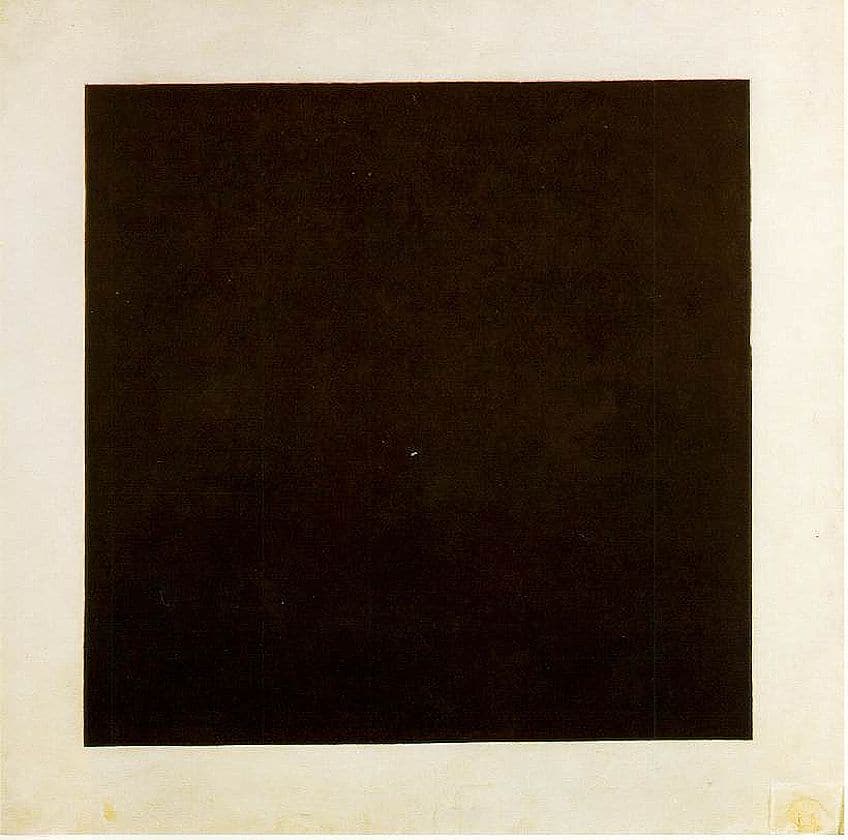
Minimalism had begun to gain traction and soon any works that evoked a sense of sleekness through reductionist techniques were considered Minimalist. That being said, Minimalism in art is said to be calculated as opposed to spontaneous. Minimalism simply stands out and does what any other artist would hope to achieve.
It provides a sense of uniqueness that no other art movement had successfully achieved with such ease.
Critiques of Minimalism Art
Minimalist art was and is not loved by all. While receiving both praise and hate, this radical art movement drew much attention regardless of which side of favor it fell on. Many critics expressed their hate for the art movement and criticized it as being too pretentious and either “unnecessarily personal” or impersonal.
Minimalism was applied to both art and design aspects, including the visual arts and music, which sought to reveal the essence of a subject by removing any unnecessary elements or concepts.
Minimalist art also acquired the name, literalist art and ABC Art, which were viewed negatively by those who preferred the opinion that art should always have meaning. The Minimalism art movement was extremely popular in New York and first featured in painting and later in sculpture. Minimalism was also becoming a popular style in Europe with the emergence of Bauhaus artists and in Russia via the Constructivist art movement.
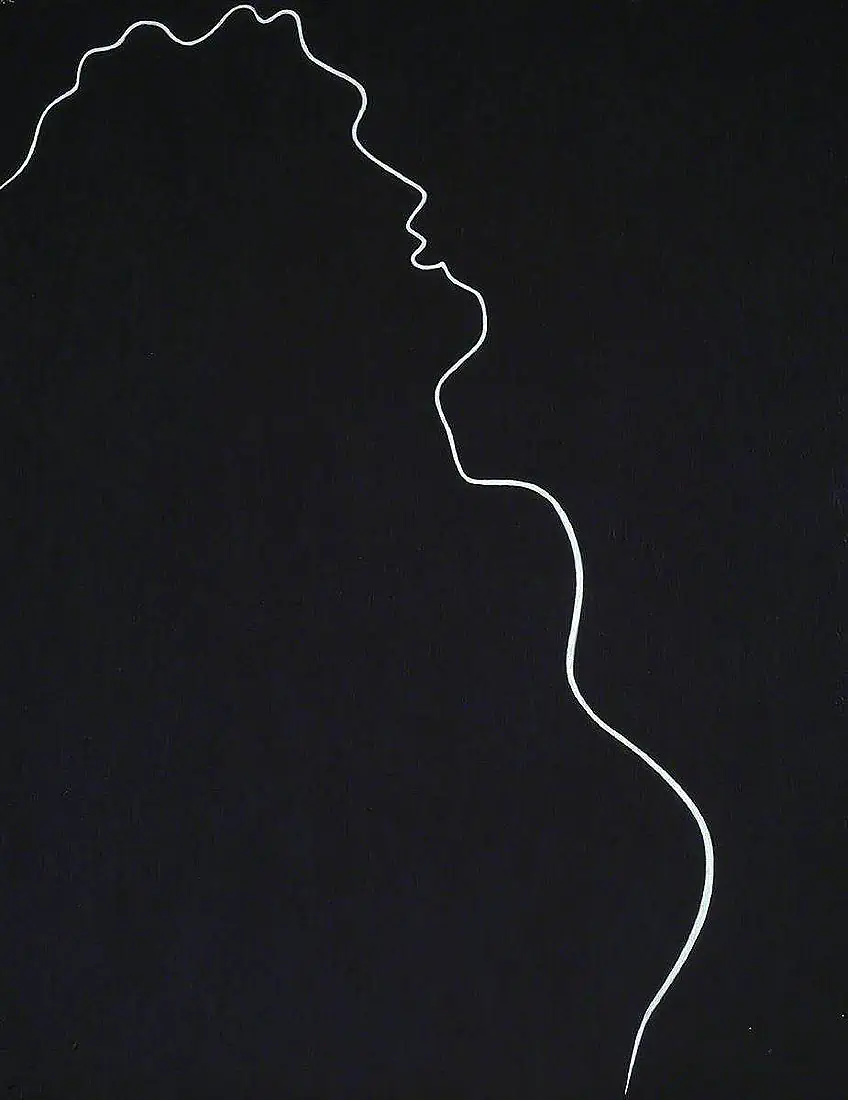
One of the most important moments for the Minimalist art movement was the group show held at the Jewish Museum in 1966 titled Primary Structures, which showcased works by Sol LeWitt, Donald Judd, Dan Flavin, and Robert Morris. The exhibition was successful, and the works exhibited consisted of “naked materials” with smooth and shiny textures. This display was a trigger point for those who thought of the role of the artist as the maker since many of the works promoted the idea of the artist as a designer.
One of the participating artists, Mark di Suvero commented that Donald Judd did not really do the “work”, therefore, he could not be considered an artist.
Judd replied to this by pointing out the flawed thinking of the artist at the time stating that he did not see the logic in why one technique was regarded as “more art than another”. The rise of Minimalism in art paved the way for broader thinking about what art is, what it can be, and what it should not be confined to. One of the most significant comments on Minimalism was made by Michael Fried, who was a formalist critic very much against the Minimalism art movement due to its display of theatricality.
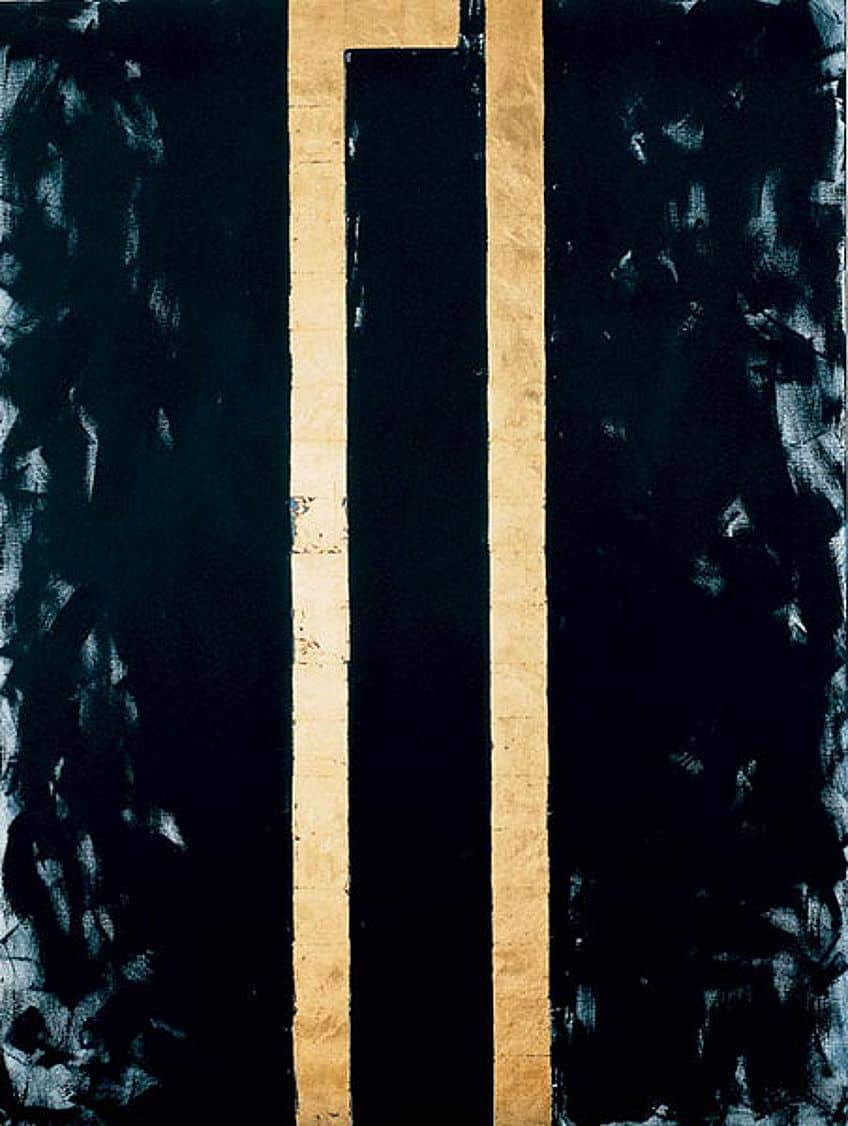
In 1967, he criticized Minimalist sculpture as being founded on the engagement with the physicality of the viewer and that artworks by artists such as Robert Morris made the act of viewing a spectacle. Fried was dissatisfied with the idea that the viewer and the act of viewing were now displaced and the experience itself was a downfall of Minimalism. The formalist critic’s opinions were challenged by Robert Smithson, who was a post-Minimalist.
Smithson issued a letter to the editor of Artforum declaring that Fried feared his own consciousness, which he implied was Fried himself being a theatrical character.
Influence of Minimalism Art
Minimalism can be regarded as having a profound impact on the aesthetic of Modernism. By introducing new ways of experiencing art, Minimalism gave way to the development of its philosophy and way of life. Minimalism was built on the foundations of simplicity and resulted in the worship of the geometricization of the human way of living.
Since the Minimalism art movement is so heavily attached to design and aesthetics, it also finds its roots in architecture, line, form, interior design, graphical design, and fashion.

The appeal of adopting a Minimalist culture and lifestyle became affiliated with an air of prestige, culture, and a preference for the classical components of art and design. Preferring Minimalist art implies a level of structure and organization that one “reads art” and lives by and is thus recognized as an appreciation for art that is unlike any other since it regresses to the basic elements of art to appreciate the innovation potential.
Minimalist art also promotes the idea of what you see is what you get.
The extension of abstraction is elevated and the idea that art (be it an object or demonstration of color) can have its reality outside of imitating a concept makes the movement significant. Minimalist art is also confrontational as it confronts the viewer with an object or artwork that is simply material, which asks the viewer to look at it as it presents itself. Minimalism directs the viewer to face reality as opposed to the concept of it.
Famous Minimalist Artists
Now that we have outlined the essence of Minimalism, we can now take a look at some of this art movement’s most famous pioneering artists. Below, you will find a list of Minimalism’s most influential artists from the 60s, well into contemporary times.
Agnes Martin (1912 – 2004)
| Artist Name | Agnes Bernice Martin |
| Date of Birth | 22 March 1912 |
| Date of Death | 16 December 2004 |
| Nationality | Canadian |
| Mediums Used | Painting |
Canadian artist Agnes Martin is a famous Minimalist and Abstract Expressionist artist who immigrated to the United States from Canada. She is most famous for her abstract paintings displaying organic and minimalist forms during her stay in New Mexico.
Martin’s unique style eventually led her to produce her signature penciled grids on canvas.
Her work was considered to be unique since it was not entirely within the realm of Abstract Expressionism and not wholly within the territory of Minimalism. According to Martin, painting was likened to “a world without objects…or obstacles” and her style was heavily influenced by her spiritual beliefs, which came from American Transcendentalist and Zen Buddhist notions.
Yves Klein (1928 – 1962)
| Artist Name | Yves Klein |
| Date of Birth | 28 April 1928 |
| Date of Death | 6 June 1962 |
| Nationality | French |
| Mediums Used | Painting, performance art |
A key pioneer of post-war art in Europe, Yves Klein is an important French Art Nouveau and Minimalist artist who drove many interesting performance art pieces. Klein was identified as a Minimalist for his extensive use of a specific shade of blue called International Klein Blue (IKB), which he viewed as the key to unlocking the sublime and expanding human imagination.
Klein was also an artist who did not undertake any formal artistic training.

Donald Judd (1928 – 1994)
| Artist Name | Donald Clarence Judd |
| Date of Birth | 3 June 1928 |
| Date of Death | 12 February 1994 |
| Nationality | American |
| Mediums Used | Painting, sculpture, etching, aquatint, woodcut, screen printing |
Best known for his contribution to post-war art and art criticism, Donald Judd is also considered one of the pioneering members of the early group of Minimalists. Judd developed his style while working as an art critic for Arts magazine.
He described his new tendency towards abstraction as employing commercial materials while focusing on real space and an “emphasis on the whole, unified shape”.

Frank Stella (1936 – Present)
| Artist Name | Frank Philip Stella |
| Date of Birth | 12 May 1936 – Present |
| Nationality | American |
| Mediums Used | Painting, sculpture, printmaking |
Recognized as America’s best Minimalist artist, Frank Stella left a lasting impression on the art world of 1960s America. His most famous painting series, called the Black Paintings, is a series of Minimalist paintings that he produced in his early twenties. His paintings were so well received that the Museum of Modern Art even purchased them. Stella’s style consists of clear-cut geometric shapes painted with acrylic paint.
As he progressed, his painting style became more complex and he employed canvases of varied sizes and shapes, thus expanding the notion of Minimalist art.

Larry Bell (1939 – Present)
| Artist Name | Larry Bell |
| Date of Birth | 6 December 1939 – Present |
| Nationality | American |
| Mediums Used | Sculpture, painting, installation, drawing |
Associated with an explorer of light and space, which is a common feature in Minimalist artwork, Larry Bell is one of the world’s most celebrated artists. Bell places focus on the properties of light as reflected and refracted by surfaces. He is best known for his glass cube sculptures, with the cube becoming an iconic symbol of Minimalism itself.
His sculptures provide viewers with a kinesthetic observation, and he also incorporates illusions of shapes to amplify the experience of the cube.
Sherrie Levine (1947 – Present)
| Artist Name | Sherrie Levine |
| Date of Birth | 17 April 1947 – Present |
| Nationality | American |
| Mediums Used | Painting, photography |
Sherrie Levine is an important American photographer who formed part of the group of artists who explored codes and strategies of representation via photography. Also recognized as a Neo-Minimalist artist, Levine is primarily an appropriation artist and a member of the Pictures Generation.
Levine is famous for her reinventions of famous artists’ works, which further examines ideas around the ownership of an artwork.
Other famous Minimalist artists include the infamous Piet Mondrian, Eva Hesse, Richard Serra, Jo Baer, Walter de Maria, Gary Kuehn, Carmen Herrera, Robert Smithson, Fred Sandback, Anne Truitt, Carl Andre, and Tony Smith, to name a few.
Famous Minimalist Artworks
Minimalism in art takes on multiple visual forms across all kinds of mediums, including painting, installation, and sculpture, to name a few. Below, you will find some of the most famous Minimalist artworks to come out of the 20th century.
Minimalist Paintings
Most early Minimalist paintings are defined by their monochromatic look. Artists like Yves Klein began painting in the classic monochrome style as early as 1949 and hosted his first exhibition of these works in 1950 to a private audience. Monochrome painting first found its roots in 1882 Paris and was a black painting by the poet, Paul Bilhaud.
Friendship (1963) by Agnes Martin
| Artist | Agnes Martin (1912 – 2004) |
| Date | 1963 |
| Medium | Incised gold leaf and oil on canvas |
| Dimensions (cm) | 190.5 x 190.5 |
| Where It Is Housed | Tate Collection |
Created in Agnes Martin’s signature style of a six-by-six-foot canvas, this Minimalist painting is a well-recognized artwork of the movement. Friendship (1963) forms part of a triptych and is crafted using gold leaf with gesso. The materiality of her painting resonates with the era of industrial production and commercial imagery.
The rich quality of her choice of material is not the only unique feature.
Martin’s immaculate attention to detail on the grid is also something to marvel at. The square format is merely the base for this grid style that eventually became Martin’s trademark of her exploration into an abstract language defined by Minimalist geometry.
The repetition of the grid also speaks to one of the characteristics of Minimalist art and how the repetition of geometry reinforces the philosophy of Minimalism.
Red Circle on Black (1969) by Yoshihara Jirô
| Artist | Yoshihara Jirô (1905 – 1972) |
| Date | 1969 |
| Medium | Silkscreen |
| Edition | 41/100 |
| Dimensions (cm) | 55.7 x 75.5 |
| Where It Is Housed | Tate Collection |
This is one of the most famous images of Minimalist painting created by the multi-talented Japanese artist Yoshihara Jirô, who displays mastery over abstract impasto gestures in his paintings. Depicted in his painting Red Circle on Black (1969) is a Zen motif of a circle screen-printed in red and black.
Jirô began his circular series in the 1960s and expanded his medium to include ink-wash paintings, watercolor paintings, sculptures, murals, and even stage designs.
Jirô was also a leader in post-war Japanese art and as an avid member of the art community, he also co-founded the Gutai Art Association in 1954, which encompassed experimental approaches to art strategies around performances and exhibitions.
Untitled (Black on Gray) (1970) by Mark Rothko
| Artist | Markus Yakovlevich Rothkowitz (1903 – 1970) |
| Date | 1970 |
| Medium | Acrylic on canvas |
| Dimensions (cm) | 203.3 x 175.5 |
| Where It Is Housed | Solomon R. Guggenheim Museum, New York City |
This acrylic painting by Mark Rothko depicts a black and gray rectangle placed one above the other. At first glance, this may seem like a simple execution but upon closer inspection, one can observe the extra translucent layers of paint in varying shades of gray and black that appear warm.
Rothko’s Untitled (Black on Grey) (1970) gives off an ambiguous experience of color and the artist describes this effect as alluding to the “historical sublime”.
Mark Rothko is a world-renowned Minimalist and Abstract Expressionist painter famous for his colorful field paintings showcasing irregular and rectangular bursts of color. He is considered one of the world’s most important artists of post-World War II Modernism and a huge contributor to pioneering monochrome painting.
During the making of this work, Rothko was already in a declining state of health since he experienced an aortic aneurysm two years prior. When questioned about the black-gray painting and his choice of color, Rothko simply stated that these paintings were about death.
In his view, he likened the colors and depiction of empty space to a desolate Arctic wasteland with a vast sky, symbolic of a deathlike state.
Minimalism and Abstract art are very much interlinked and it can be said that abstraction is an element of Minimalist art. Many Minimalist Abstract artworks are often accompanied by a conceptual basis or as in the case of Rothko’s black and gray paintings, abstract thoughts and concepts can easily find themselves under the aesthetic of Minimalism.
Franklin’s Footpath (1972) by Gene Davis
| Artist | Gene Davis (1920 – 1985) |
| Date | 1972 |
| Dimensions (m) | 126.1 |
| Genre | Site-specific |
| Where It Is Housed | Philadelphia Museum of Art, Washington D.C. |
Gene David was a famous American color field painter and leader in Minimalist striped artwork. Color field painting is identified as a subcategory of Abstract art in New York during the 1940s that was inspired by European Modernism.
Gene Davis was incredibly popular for his vertical stripes, as seen in the major painting project Franklin’s Footpath, which Davis created in 1972.
In the 1970s, this work was considered the largest artwork in the world. Franklin’s Footpath is made up of many colorful vertical stripes in front of the Philadelphia Museum of Art. A painter of opposites, Davis also made many micro paintings.
Minimalist Sculptures
The appearance of Minimalism can also be traced back to Europe with sculptors like Constantin Brâncuși, who was a Romanian sculptor considered to be one of the pioneers of Modernism. Some Minimalist artists expressed their intention toward creating Minimalist Abstract artworks as exclusive of their self-expression and rather aimed at the expression of an objective. Below, we will look at some of the most famous Minimalist sculptures for insights into other characteristics found in three-dimensional Minimalist artworks.
Three Elements (Untitled) (1966 – 1967) by Ronald Bladen
| Artist | Ronald Bladen (1918 – 1988) |
| Date | 1966 – 1967 |
| Medium | Painted and burnished aluminum |
| Dimensions (cm) | 305.8 x 122.9 x 54.6 per element |
| Where It Is Housed | Museum of Modern Art, New York |
Ronald Bladen is considered to be the founding father of Minimalist sculpture. Having first ventured into Abstract Expressionist painting, Bladen soon found his way to Minimalistic sculpture with his first sculpture White Z, which was a monochromatic abstract piece built out of smaller parts.
Bladen soon went on to build monumental-sized Minimalistic sculptures that took on an equally monumental medium, aluminum, which adds to the edgy and sharp nature of his modern sculptures.
Ronald Bladen’s intention around sculptures, such as his Three Elements above, was to construct an object that would leave a long-lasting presence in the environment. Bladen was more so invested in the effect of the sculpture rather than its form.
Untitled (mirrored cubes) (c. 1965/1971) by Robert Morris
| Artist | Robert Morris (1931 – 2018) |
| Date | c. 1965/1971 |
| Medium | Mirror glass and wood |
| Dimensions (cm) | 91.4 x 91.4 x 91.4 |
| Where It Is Housed | Tate Collection, London |
Robert Morris was elevated into the spotlight during the height of Minimalist art. His famous mirrored cubes crafted between 1965 and 1971 were set up in the garden of Tate Modern for his 1971 show. Morris regarded these sculptures and installation set-ups as a situation whereby the viewer had to navigate the presence of the sculpture alongside the reflection and presence of self.
This highlighted the conceptual nature of Minimalist art and draws attention to the relationships created by the mirrors, the room, and the viewer.
By simply adding a mirror surface to the wooden cubes, Morris elevated the idea of Minimalist art as more than appreciative of materiality but rather a prompt for further conceptual consideration. Minimalist art can therefore be said to assist in the gesture of demonstrating otherwise abstract ideas.
Morris also described sculpture as situated in the central part of a continuum of “useless three-dimensional things” and can range from the size of monuments to ornaments.
Rainbow Pickett and Trinity (1965; 2004) by Judy Chicago
| Artist | Judy Chicago (1939 – Present) |
| Date | 1965 |
| Medium | Plywood |
| Dimensions (cm) | 320 x 320 x 279.4 |
| Where It Is Housed | Judy Chicago Studio |
Debuting at the Rolf Nelson Gallery in 1966, Los Angeles, this sculpture by Judy Chicago was a room-sized installation that consists of six multi-colored trapezoids with varying lengths. Rainbow Pickett was also exhibited at the Jewish Museum, which hosted the first major Minimalist exhibition.
According to the art critic Clement Greenberg, Chicago’s installation was “the best work” out of the group show.
The sculptural installation was again set up in 2004 due to the original sculpture being destroyed by the artist herself because of high storage fees. Judy Chicago is a feminist artist whose work deals with themes of birth, creation, and the role of women in history. Another famous work by Chicago is the famous triangular Dinner Party (1974 – 1979) table.
Minimalist Installations: Light
Minimalist art also includes installations, which are closely related to sculpture in that many installations are made up of multiple sculptural objects, however, with installation, the focus is on the experience and the environment that encapsulates the artwork. Many Minimalist installations are centered on light and space, which is important to the experience of an installation or any artwork for that matter.
Minimalist artists would often use fluorescent lights to “sculpt” space and create a new atmosphere of different color zones.
Space itself, alongside light, becomes an element of Minimalist installation art. Dan Flavin is one such artist whose work revolves around fluorescent lighting in installations and he is credited with making the first icons. Other artists that worked with light and space and formed part of the “Light and Space” movement included James Turrell, Mary Corse, Robert Irwin, Bruce Nauman, John McCracken, Maria Nordman, and Helen Pashgian.
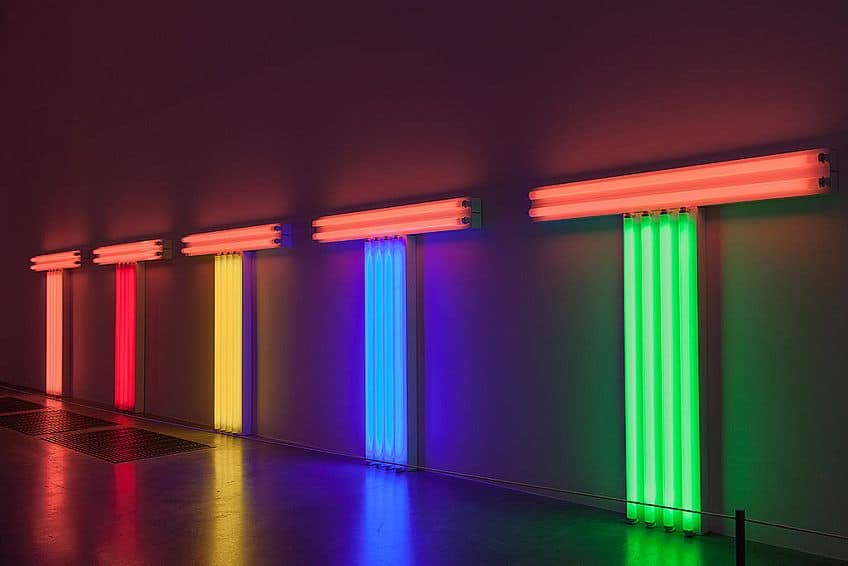
The characteristics of the light and space movement included the use of unconventional materials such as polyester resin, the incorporation of light, space, and an element of multi-dimensionality to create an immersive experience. There are different functions for Minimalist art since its emergence and re-emergence back into contemporary art. Minimalist art can now be found almost everywhere and is most often featured in home and design stores.
Due to the nature of Minimalistic art, which is mostly based on aesthetic pleasure and materiality, Minimalism has moved beyond the realm of art and into the daily life of many as an “aesthetic, conscious, and simple” way of living.
How to Make Minimalist Art
Have you ever wondered how to make Minimalist art? Well, we have a few tips on how you can begin to create your unique artworks to complement your style, color preference, concept, and practice. Below are just a few Minimalist painting ideas to inform your approach to Minimalist art making.
Minimal Line Art
One of the easiest ways to create some Minimalist art is to try your hand at Minimal line art. The first step is to decide on your color palette for a background, which can be any neutral color with white being the most common. The next step is to paint some organic shapes onto the white primed canvas or paper. Organic shapes refer to shapes that have no rigid edges, as seen in geometric shapes, and evoke a sense of fluidity. You will also want to make sure you simplify your selection in color down to two main neutral colors.

Pastel color palettes make for great Minimalist artworks. Once you have painted on your organic shape and left it to dry, you can then use a black paint marker to draw a silhouette of a face or freeform line over the organic filed-in shapes. Keep the line with as minimal loops or design elements as possible for a true Minimalist aesthetic. Remember that less is more.
Silkscreen Printing
Another option for color is to make sure you select two contrasting colors and you may layer one color on top of another. One way to achieve a sense of structure if you prefer a less organic appearing artwork is to employ the medium of silk screen printing.
Silkscreen printing, also called serigraphy, is a popular printing method that involves the use of a mesh frame to transfer ink onto a surface such as paper or fabric.
A blade is traditionally moved across the mesh frame to transfer the ink and the mesh acts as a kind of stencil that contains parts that do not allow the ink to transfer through, thus enabling you to create different images or text. Much recognition was given to screen-printing after the famous pop art artist Andy Warhol made it popular in the 1960s. By creating a stencil with geometric shapes or simple patterns, you can easily make your Minimalist art.
Minimalist Abstract Painting
One of the easiest Minimalist painting ideas includes using a gelatin or Perspex plate, presumably in a rectangular or square form, and painting directly on the plate with a color of your choice. You can also be bold and explore metallic colors with high-contrast colors such as black. You can then apply the paper over the plate, which acts as a stamp and this makes it easier to transfer the color onto the surface of the paper and for abstract marks to emerge in a way that seems less forced.

For more texture in creating your abstract Minimalist painting, you can include texture pastes such as filler or plaster as the background of your painting and inlay lines, geometric markings, or curves over the texture so that it dries with some shape in it. These make for simple and aesthetically pleasing artworks.
Painting With Tape
Another super easy method for creating a Minimalist painting includes using tape to block out different areas of your canvas or paper and painting over the entire canvas. This creates negative spaces once you remove the tape.
When used creatively, you can either make a polychrome or monochrome painting using the rigid lines left by the tape.
Reductive Painting
Reductive painting is a great way to transform old paintings or artworks and can even be executed over photographs. Reductive painting involves the removal of paint from a surface to reveal the underlying color, which in turn, defines the artwork or shape. Reductive paintings can be made by applying a glaze over an existing artwork. You then use the Italian method of carving into the painting to create lines, called sgraffito to outline the shape.
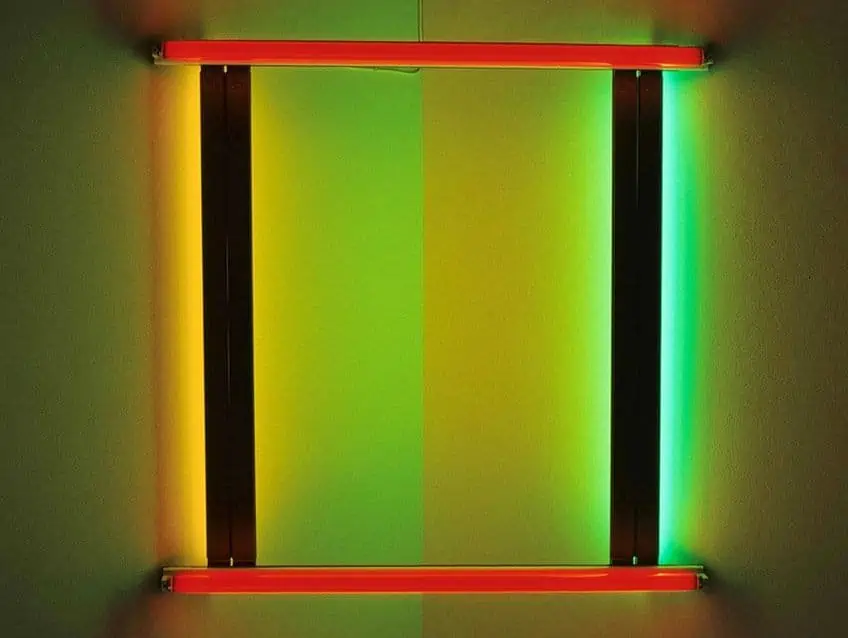
To commence the reductive part of the process, you may use a cloth with rubbing alcohol to remove areas inside the shape you carved out. This method can help you create either an abstract Minimalist painting or a controlled painting. Other easy mediums that you can use to create Minimalist art include photography and the simple act of installing LED lights in your favorite pass-time room to create a Minimalist space for relaxation or contemplation. By incorporating some of the characteristics of Minimalist art, you can explore other creative ways to make your Minimalist art.
Minimalism continues to thrive in the 21st century whether loved or hated. Minimalist art encompasses art that is both complex, conceptual, simple, aesthetic, and modern, while also being a critique of art itself. There seems to be no strict definition of Minimalism other than its state of preference for art that falls under the ease of observation and the charm of both concept and lack thereof.
Take a look at our Minimalism art webstory here!
Frequently Asked Questions
What Is the Minimalism Art Movement?
Minimalist art is an art form that emerged during the 1950s aimed at the simplification of what people thought art to be. Minimalist art focuses less on the message of the artwork and more on the material and form. Minimalist art allows viewers to form their meaning from the lack of expression in art. Minimalist art can take the form of Abstract art, sculpture, photography, and any form that follows the characteristics of Minimalist art.
What Are the Characteristics of Minimalist Art?
The characteristics of Minimalist art include the presence of geometric forms or organic shapes exclusive of any additional expression that complicates the work. Other characteristics include light, specifically fluorescent lighting, space, line, and the use of the ready-made or found object as sculpture. Minimalist art seeks to reverse the role of expectation in a gallery space and invites the viewer to participate in self-interpretation and self-reflection. Another key feature of Minimalist art is repetition and order.
What Is the Benefit of Minimalist Design in Art?
Minimalist designs or elements in art remove any distracting elements around an artwork and incite the observer to confront themselves by simply presenting the surface value and materiality of the object, text, or artwork in question. Minimalist design helps the viewer focus on what is in front of them and when used conceptually, it can help the viewer focus on what is not in front of them.
Who Are the Most Famous Minimalist Artists?
The most famous Minimalist artists include Frank Stella, Larry Bell, James Turrell, Piet Mondrian, Donald Judd, Sol LeWitt, Ronald Bladen, Agnes Martin, and Richard Serra.
What Contributed to the Beginning of Minimalism?
Russian Constructivism is believed to be the movement that influenced the beginning of Minimalism. The Russian Constructivism movement was formed as a rejection of decorative stylization and favored industrial materials in assemblages. The movement began in 1915 and was founded by Alexander Rodchenko and Vladimir Tatlin. The art from this movement is described as an abstract reflection of modern industrial society.
Jordan Anthony is a Cape Town-based film photographer, curator, and arts writer. She holds a Bachelor of Art in Fine Arts from the University of the Witwatersrand, Johannesburg, where she explored themes like healing, identity, dreams, and intuitive creation in her Contemporary art practice. Jordan has collaborated with various local art institutions, including the KZNSA Gallery in Durban, the Turbine Art Fair, and the Wits Art Museum. Her photography focuses on abstract color manipulations, portraiture, candid shots, and urban landscapes. She’s intrigued by philosophy, memory, and esotericism, drawing inspiration from Surrealism, Fluxus, and ancient civilizations, as well as childhood influences and found objects. Jordan is working for artfilemagazine since 2022 and writes blog posts about art history and photography.
Learn more about Jordan Anthony and about us.
Cite this Article
Jordan, Anthony, “Minimalist Art – An Investigation into the Minimalism Art Movement.” artfilemagazine – Your Online Art Source. November 7, 2022. URL: https://artfilemagazine.com/minimalist-art/
Anthony, J. (2022, 7 November). Minimalist Art – An Investigation into the Minimalism Art Movement. artfilemagazine – Your Online Art Source. https://artfilemagazine.com/minimalist-art/
Anthony, Jordan. “Minimalist Art – An Investigation into the Minimalism Art Movement.” artfilemagazine – Your Online Art Source, November 7, 2022. https://artfilemagazine.com/minimalist-art/.


